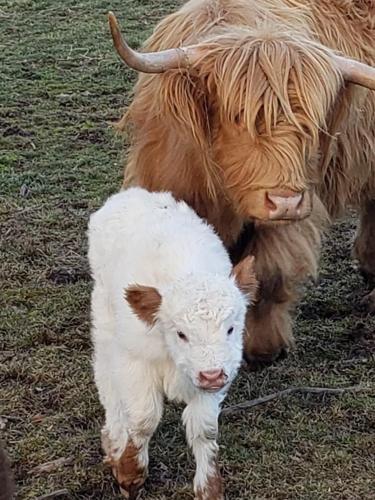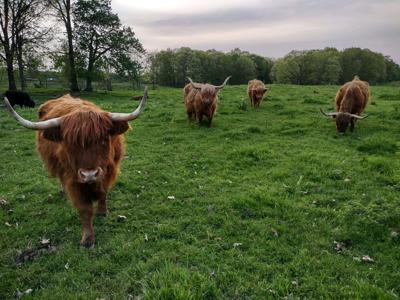Nate Halteman bought his first Scottish Highland a few years ago because he liked the unique appearance of the heritage breed.
After Halteman raised and processed his first Highland steer, he found there was something else he liked as well.
“The meat is really flavorful, lean but with good marbling,” said Halteman, who raises six Highland cattle on his 18-acre farm in Green Lane, Pennsylvania. “It’s similar to venison in that it’s lean and has one of the highest protein contents and lowest cholesterol contents among bovines.”
The number of people raising Highland cattle is growing, according to Judy Ligo, who has raised the breed on her LiTerra farm in Grove City, Pennsylvania, since 1995.
There are 31 Pennsylvania farms listed on the Mid-Atlantic Highland Association’s website, and Ligo said many people raise the beef breed as a novelty.

Nate Halteman brought a few Highland cattle to his Montgomery County farm to keep the pastures down. He bred a few of the heifers and was amazed at how easily they calved.
That’s how Ligo and her husband, John, got started with Highlands.
“We got them to keep the pastures down, but we really liked them,” she said. “Now we have 30 cows with calves and sell a lot of breeding stock.”
Ligo said interest in Highlands has grown in the last few years due in large part to their unique appearance, with long, thick coats and impressive horns. Prices have skyrocketed as well, and Halteman said a good registered cow can bring up to $10,000.
People are also attracted to Highlands because of the breed’s simplicity.
Highlands are excellent grazing cattle that are very self-sufficient and hardy. The breed is intelligent and very docile, Ligo said.
And they’re efficient.

Highland cattle are known for their ability to thrive on a grass-fed operation, but they also calve easily and have good maternal instincts.
Halteman said Highland cattle grow a second coat of hair in the winter and really don’t produce a fat layer.
“It takes a lot of energy to produce a fat layer, and with Highlands, it’s more efficient to produce that hair to keep warm than fat,” he said. “It’s not uncommon for them to gain weight in the winter on hay because they can put the calories toward growth instead of keeping warm, thanks to the hair.”
All of that hair serves as another benefit, Ligo added, as Highlands have become popular with those who show cattle. Highlands have won some major shows, she said, and handlers like them because there is a lot of hair to work with during preparation.
Still, Halteman acknowledged the breed has characteristics that some people might not like. They are smaller-framed than the average beef cattle, and they take much longer to finish — up to three years.
“If you’re wanting to do this on a large scale, it might not be beneficial to have an animal that takes an extra year to finish,” he said.
Ligo said her 30-cow Highland herd is on the larger side, and most people keep between five and 10.
Angus-Highland Crosses Come With Benefits
Ligo also raises 200 commercial Angus cattle. She has crossed many of them with Highlands, and the results have been impressive.
The hybrid vigor makes an excellent animal, and the crosses typically don’t have horns because the polled Angus is dominant, she said. The hair on the crosses isn’t as long, but the marbling found in Highlands still persists.
The Angus-Highland crosses also sell well at auction.
“If you take purebred Highland cattle to auction, the price is terrible because the processors don’t want to deal with the horns,” she said. “You don’t have that with the crosses.”
Ligo said it’s difficult to expand her Highland herd right now because there is so much demand for breeding stock that she’s always selling animals.
Halteman is content to stick with six Highlands on his 18 acres, raising them for the freezer and to maintain the property.
So far, they’ve been good at both.
“They clear out the brush and vegetation. It’s like having goats on steroids,” he said. “Since I’ve gotten Highlands, I know of three other people that have bought some. They’re friendly, efficient and don't take up a lot of space, and that appeals to a lot of people.”




